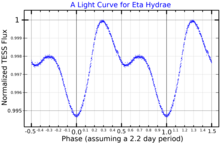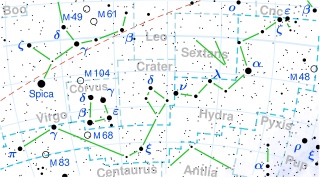Eta Hydrae
| Observation data Epoch J2000.0 Equinox J2000.0 (ICRS) | |
|---|---|
| Constellation | Hydra |
| Right ascension | 08h 43m 13.47499s[1] |
| Declination | +03° 23′ 55.1867″[1] |
| Apparent magnitude (V) | 4.294[2] |
| Characteristics | |
| Spectral type | B3 V[3] |
| U−B color index | −0.726[2] |
| B−V color index | −0.187[2] |
| Variable type | Candidate β Cep[4] |
| Astrometry | |
| Proper motion (μ) | RA: −19.39[1] mas/yr Dec.: −1.08[1] mas/yr |
| Parallax (π) | 5.56 ± 0.24 mas[1] |
| Distance | 590 ± 30 ly (180 ± 8 pc) |
| Absolute magnitude (MV) | −1.48[5] |
| Details | |
| Mass | 7.0±0.1[6] M☉ |
| Radius | 3.9[7] R☉ |
| Luminosity (bolometric) | 2,680[8] L☉ |
| Surface gravity (log g) | 3.933[9] cgs |
| Temperature | 18,630±411[9] K |
| Rotational velocity (v sin i) | 101±5[9] km/s |
| Age | 31.6±3.9[6] Myr |
| Other designations | |
| Database references | |
| SIMBAD | data |
Eta Hydrae (η Hydrae) is a star in the equatorial constellation of Hydra. With an apparent visual magnitude of 4.3,[2] it is visible to the naked eye. However, it is the faintest of the five stars that form the "head" of the hydra.[11] Based upon an annual parallax shift of 5.56 mas,[1] it is located roughly 590 light years from the Sun.

This is a B-type main sequence star with a stellar classification of B3V.[3] It has been classified as a candidate Beta Cephei variable with a period of 2.2 days, although this designation was rejected by Stankov and Handler (2005).[4] The spectrum shows a slight underabundance of carbon, compared to the Sun.[13] The star is around 32[6] million years old and is spinning with a projected rotational velocity of 101[9] km/s. It has an estimated seven[6] times the mass of the Sun and nearly four[7] times the Sun's radius. Eta Hydrae radiates 2,680[8] times the solar luminosity from its outer atmosphere at an effective temperature of 18,630[9] K.
Name and etymology
[edit]This star, along with δ Hya (Lisan al Sudja), ε Hya, ζ Hya, ρ Hya and σ Hya (Minchir), were Ulug Beg's Min al Azʽal, "Belonging to the Uninhabited Spot".[14] According to the catalogue of stars in the Technical Memorandum 33-507 - A Reduced Star Catalog Containing 537 Named Stars, Min al Azʽal or Minazal were the title for five stars:δ Hya as Minazal I, η Hya as Minazal II, ε Hya as Minazal III, ρ Hya as Minazal IV and ζ Hya as Minazal V (exclude σ Hya).[15]
In Chinese, 柳宿 (Liǔ Sù), meaning Willow, refers to an asterism consisting of η Hydrae, δ Hydra, σ Hydrae, ρ Hydrae, ε Hydrae, ζ Hydrae, ω Hydrae and θ Hydrae[16] Consequently, η Hydrae itself is known as 柳宿三 (Liǔ Sù sān, English: the Third Star of Willow).[17]
The people of Groote Eylandt called Unwala, "The Crab", for the star cluster including this star, δ Hya (Lisan al Sudja), ε Hya, ζ Hya, ρ Hya and σ Hya (Minchir).[18]
References
[edit]- ^ a b c d e f van Leeuwen, F. (2007), "Validation of the new Hipparcos reduction", Astronomy and Astrophysics, 474 (2): 653–664, arXiv:0708.1752, Bibcode:2007A&A...474..653V, doi:10.1051/0004-6361:20078357, S2CID 18759600.
- ^ a b c d Oja, T. (August 1986), "UBV photometry of stars whose positions are accurately known. III", Astronomy and Astrophysics Supplement Series, 65 (2): 405–409, Bibcode:1986A&AS...65..405O.
- ^ a b Levenhagen, R. S.; Leister, N. V. (2006), "Spectroscopic Analysis of Southern B and Be Stars", Monthly Notices of the Royal Astronomical Society, 371 (1): 252–62, arXiv:astro-ph/0606149, Bibcode:2006MNRAS.371..252L, doi:10.1111/j.1365-2966.2006.10655.x, S2CID 16492030.
- ^ a b Stankov, Anamarija; Handler, Gerald (June 2005), "Catalog of Galactic β Cephei Stars", The Astrophysical Journal Supplement Series, 158 (2): 193–216, arXiv:astro-ph/0506495, Bibcode:2005ApJS..158..193S, doi:10.1086/429408, S2CID 119526948.
- ^ Ammler-von Eiff, Matthias; Reiners, Ansgar (June 2012), "New measurements of rotation and differential rotation in A-F stars: are there two populations of differentially rotating stars?", Astronomy & Astrophysics, 542: A116, arXiv:1204.2459, Bibcode:2012A&A...542A.116A, doi:10.1051/0004-6361/201118724, S2CID 53666672.
- ^ a b c d Tetzlaff, N.; et al. (January 2011), "A catalogue of young runaway Hipparcos stars within 3 kpc from the Sun", Monthly Notices of the Royal Astronomical Society, 410 (1): 190–200, arXiv:1007.4883, Bibcode:2011MNRAS.410..190T, doi:10.1111/j.1365-2966.2010.17434.x, S2CID 118629873.
- ^ a b Pasinetti Fracassini, L. E.; et al. (February 2001), "Catalogue of Apparent Diameters and Absolute Radii of Stars (CADARS)", Astronomy and Astrophysics, 367 (3rd ed.): 521–524, arXiv:astro-ph/0012289, Bibcode:2001A&A...367..521P, doi:10.1051/0004-6361:20000451, S2CID 425754.
- ^ a b Hohle, M. M.; et al. (April 2010), "Masses and luminosities of O- and B-type stars and red supergiants", Astronomische Nachrichten, 331 (4): 349, arXiv:1003.2335, Bibcode:2010AN....331..349H, doi:10.1002/asna.200911355, S2CID 111387483.
- ^ a b c d e Huang, W.; Gies, D. R. (August 2008), "Stellar Rotation in Field and Cluster B Stars", The Astrophysical Journal, 683 (2): 1045–1051, arXiv:0805.2133, Bibcode:2008ApJ...683.1045H, doi:10.1086/590106, S2CID 18926523, 1045−1051.
- ^ "eta Hya". SIMBAD. Centre de données astronomiques de Strasbourg. Retrieved 2017-01-03.
- ^ Moore, Patrick (2013), The Observer's Year: 366 Nights of the Universe, The Patrick Moore Practical Astronomy Series, Springer Science & Business Media, p. 79, ISBN 978-1447136132.
- ^ "MAST: Barbara A. Mikulski Archive for Space Telescopes". Space Telescope Science Institute. Retrieved 8 December 2021.
- ^ Schnerr, R. S.; et al. (June 2008), "Magnetic field measurements and wind-line variability of OB-type stars", Astronomy and Astrophysics, 483 (3): 857–867, arXiv:1008.4260, Bibcode:2008A&A...483..857S, doi:10.1051/0004-6361:20077740, S2CID 53454915.
- ^ Allen, R. H. (1963), Star Names: Their Lore and Meaning (Reprint ed.), New York, NY: Dover Publications Inc, p. 249, ISBN 0-486-21079-0, retrieved 2010-12-12
- ^ Rhoads, Jack W. (November 15, 1971), Technical Memorandum 33-507-A Reduced Star Catalog Containing 537 Named Stars (PDF), Jet Propulsion Laboratory, California Institute of Technology
- ^ (in Chinese) 中國星座神話, written by 陳久金. Published by 台灣書房出版有限公司, 2005, ISBN 978-986-7332-25-7.
- ^ (in Chinese) AEEA (Activities of Exhibition and Education in Astronomy) 天文教育資訊網 2006 年 5 月 28 日 Archived 2011-05-22 at the Wayback Machine
- ^ Selin, Helaine, ed. (1997), Encyclopaedia of the history of science, technology, and medicine in non-western cultures, Dordrecht: Kluwer Academic Publishers, p. 105, ISBN 9780792340669

